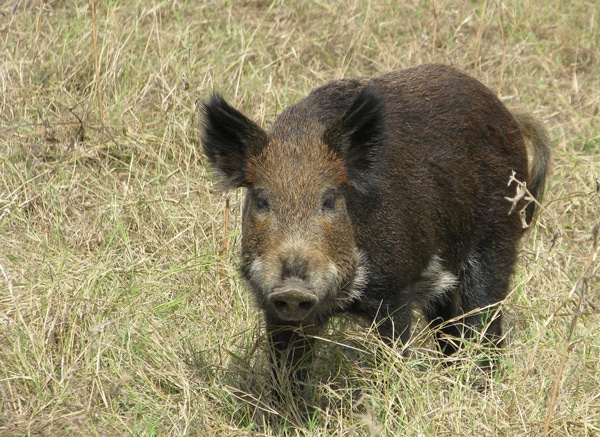
Problems with predation.Predation losses account for 2percent to 11 percent of the annual total value of sheep production and routinely accounts for greater than 50 percent of the annual death loss of lambs.Predation losses generally account for 1 percent to 2 percent of total cattle inventory as well and greater than 5 percent of total calf inventory (in 2002).

Anyone who has spent quality time on a farm or ranch or at a remote country campground has probably heard the sounds natural predators.
You may have heard the lonely sound of a coyote or wolf serenading the moon and stars on a cloudless night. On rare occasions you may have listened to the more frightening sound of a mountain lion screaming or the roar of a mother bear as it protects its cubs from other predators. And who hasn’t heard the screech of an eagle or hawk or the buzzing of a wasp in search of smaller insects on which to prey?
While such sounds can be disturbing for young children or even frightening to people who live in urban areas and rarely hear such natural sounds, they can also be disturbing to farmers and ranchers who coexist with the many animals of the wild, creatures that can have a major impact on their agricultural operations.
For centuries humans have attempted to control populations of mammalian predators to protect livestock populations. The U.S. government officially entered the predator control arena in 1915 when Congress appropriated funds for the control of wolves and coyotes. Federal and state agencies have since invested significant public resources to control predators to protect and to compensate agricultural producers for incurred losses. In 2007, for example, USDA-APHIS invested over $39 million in predation programs.
In addition to public funds, individual farmers and ranchers have spent millions in predator control and have suffered even greater amounts in losses to predators. Predation continues to have a measurable financial impact on many sectors of the agricultural economy. This is particularly true for the production of sheep and lambs in Texas and western states, where the value of losses due to predators, primarily coyotes, exceeded $6 million in 1994, 1999 and in 2004.
These losses account for 2percent to 11 percent of the annual total value of sheep production and routinely accounts for greater than 50 percent of the annual death loss of lambs. Predation losses generally account for 1 percent to 2 percent of total cattle inventory as well and greater than 5 percent of total calf inventory (in 2002).
In central and west-central Texas, predator control is a routine practice to protect agricultural interests. The region is rich in sheep and goat production and is well known for its abundant cow and calf operations.
But while problems with predators was once thought to be limited to livestock operations, the growth of feral swine problems, especially across Texas, has seen an extreme increase in the number of farms suffering crop losses as a result of predation, and these losses have been significant. In Texas alone, agricultural losses related to feral swine accounted for an estimated $52 million last year.
In one incident of peanut crop damage last year, $39,600 in production loss was attributed to feral hog activities. The variety of field crop resources damaged by feral swine include, corn, milo, rice, watermelon, peanuts, hay, turf, wheat and other grains.
Feral hogs
Swine damage to field crops results both from feeding and from feeding related activities such as trampling and rooting. As would be expected, the heaviest damage often occurs toward the end of the growing season when crops are, or nearly are, mature. In addition, feral swine prey on lambs, kids, fawns and ground nesting birds.
Feral swine feeding activities can have a negative effect on the availability of food resources for both livestock and wildlife. Wild hog populations compete with resident deer and turkey populations for limited resources. Feral swine are omnivorous and feed on a wide variety of items, many of which are staples for native wildlife.
Kerr, Edwards and Real counties in the Texas Hill Country are particularly vulnerable to wild hog predation. In addition to the large number of sheep and goat operations, the delicate balance of wildlife is being adversely affected as swine populations increase at an alarming rate. In addition, damage to fields and forage is increasing as the number of swine grows.
A “Feral Hog and Predator Management Workshop” has been set for March 26, 9 a.m.-2:30 p.m. at the Kerr Wildlife Management Area, 2625 Farm-to-Market 1340, 12 miles northwest of Hunt, Texas.
“The day’s program will include retired trapper Charlie Baird,” said program coordinator Roy Walston, AgriLife Extension agent for agriculture and natural resources, Kerr County. “Charlie is a wealth of knowledge and will share his years of experience in trapping and interpret the ‘vocabulary’ of the coyote and mountain lion.”
Walston said another workshop presenter, Cameron Martin, will discuss the economics of hog trapping and some of the current feral hog research being conducted at the management area.
“Remote trapping systems and hog-proof fencing and construction will be discussed,” he said.
Preregistration workshop fee is $25, $30 for at-the-door registration. The cost includes lunch, refreshments and all educational materials. Attendees should preregister by March 22 by contacting the AgriLife Extension office in Kerr County at 830-257-6568, Edwards County at 830-683-4310 or Real County at 830-232-6673.
Like what you're reading? Subscribe to Southwest Farm Press Daily and get the latest news delivered right to your inbox.
You also might like:
Profiting from the feral swine invasion
New publication: Feral Hog Approved Holding Facility Guidelines in Texas is now available
About the Author(s)
You May Also Like



